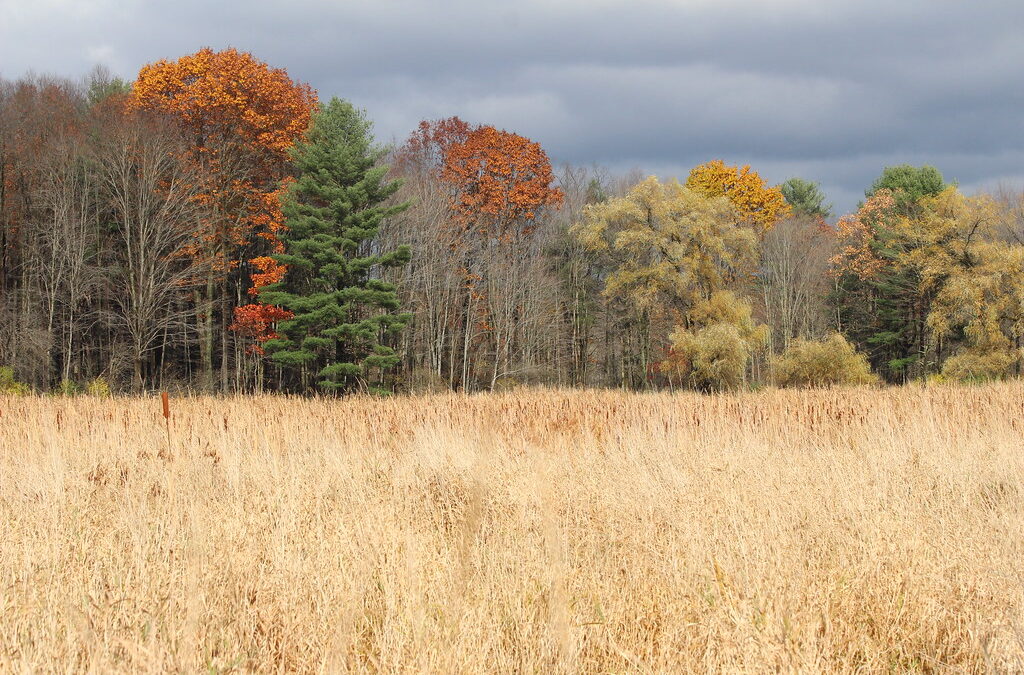By Jeff Tome, Public Engagement Specialist
Fall creeps south like a devouring beast, rampaging over the hills and valleys and sending animals fleeing from its path. Tiny birds escape to the south in September, when the first hint of the fall beast’s arrival shows in the changing color of a few leaves here and there. Warblers and hummingbirds wing to a whole other continent to get away, some travelling over 1,000 miles to find a place that stays warm through the winter. Groundhogs fatten up till they look like furry balls of Jell-O with legs, running with jiggling and joggling bodies to their underground winter burrows. Chipmunks compete for the fall seed harvest, chipping loudly in the forest as they maneuver to store up the most acorns. Sometimes they even sneak over and steal acorns from another chipmunk’s hole. “Fall is coming!” seems to echo through the air.

People have delightful names for it: “Peak Leaf Season” and “Leaf Peeper Time.” They look at foliage maps and search online for the National Leaf Forecast. They go for drives and pick apples and pumpkins and rake leaves into colorful piles. But let’s face it, fall is a monster traveling south. It turns the trees to flaming colors for one or two beautiful weeks, then strips them bare. Many plants die in the fall beast’s wake, leaving only their seeds behind. Others only die above-ground, leaving roots that can re-sprout next year. Even the sap in the trees hides underground as fall passes through. Once fall passes through an area, nothing is the same.
You can watch on a map where fall is at its peak. Go there a week later and the land looks like it has been laid to waste. The trees are naked. The animals are more visible and more vulnerable than they have been in months. The critters are frantically putting on weight, storing food, or finding safe places to freeze solid, depending on the species and their preference. If you were an alien dropped onto this planet with no knowledge of the seasons, it would look like some terrible disease came out of the north, killing all the trees and sending animals fleeing and into hiding as it traveled inexorably south, destroying almost everything in its path.
Other animals seem to revel in the destruction left by fall. Some birds creep through in November, laughing at the bare trees and the animals shivering in their dens. Sparrows migrate through the stick forests of late October and November. Perhaps that allows them to find the seeds and berries that fuel their southward migration, but I like to think they wait until there is less color in the land so that their subtle brown patterns stand out more.
Many waterfowl wait until the fall beast has passed as well, arriving well after the leaves have drifted to the ground. I like to think the ducks, geese and swans that make up fall waterfowl bring in the truly foul weather. They start migrating in greater numbers in late October and early November, towards the end of meteorological fall, which is over on November 30. Tundra Swans often seem to ride in on the first snowstorm of the year. Basically, once the swans and ducks have passed through, fall is over and winter is beginning.

Now, you may think that I really hate fall as I picture it ravaging the land like a migrating beast, but I truly love the season. My overactive imagination can’t help but picture autumn as a monster that flares the trees into colors and leaves devastation in its wake, but I also love fall. What is there not to love? The smell of fresh-fallen leaves washes over me when I step outside. The taste of fall apples fills my mouth as often as I can stuff one in. I love watching the birds migrate, the pudgy groundhogs run, and the wooly bear caterpillars wander about looking for a winter home. I have even learned to love all the people that make predictably bad predictions about winter based on the stripes of those wooly bears. Fall is magic, but it is also a force of destruction that leaves the world ready for the frigid months of winter ahead.
Audubon Community Nature Center builds and nurtures connections between people and nature. ACNC is located just east of Route 62 between Warren and Jamestown. The trails are open from dawn to dusk and birds of prey can be viewed anytime the trails are open. The Nature Center is open from 10 a.m. until 4:30 p.m. daily except Sunday when it opens at 1 p.m. More information can be found online at auduboncnc.org or by calling (716) 569-2345.


Recent Comments